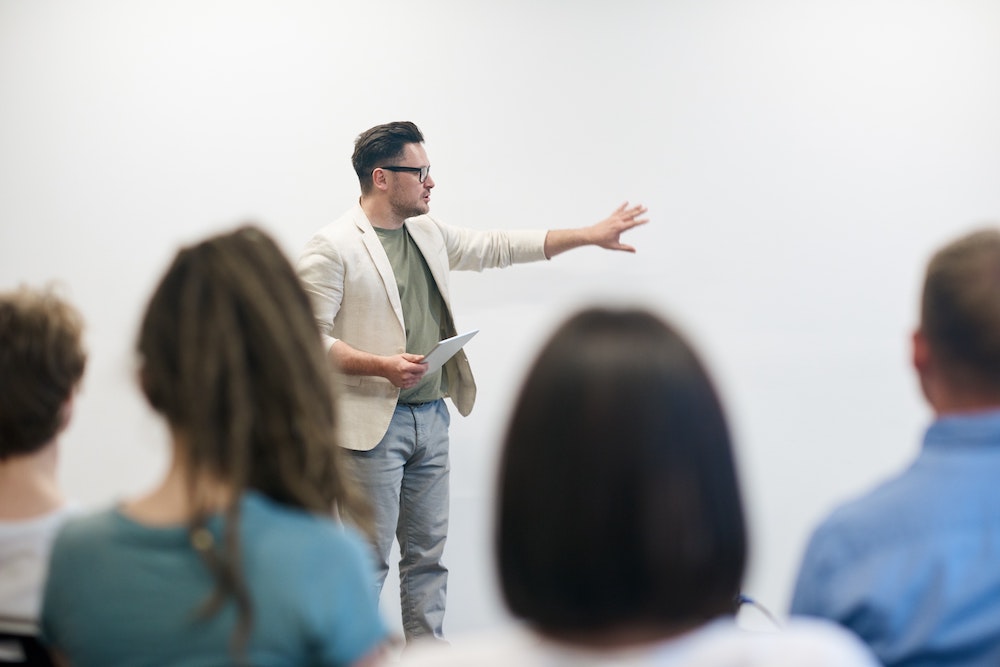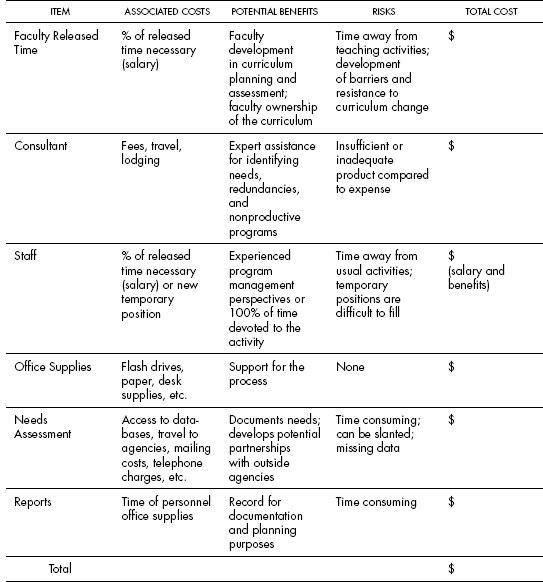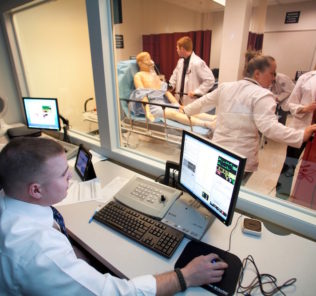Planning a Community College Simulation Program – Where to Start: Part 3
This article is the third in a three part series from HealthySim staff writer Kim Baily PhD, MSN, RN, CNE, Simulation Coordinator for Los Angeles Harbor College, on Starting a Community College Healthcare Simulation Program. Over the past 15 years Kim has developed and implemented several college simulation programs and currently chairs the Southern California Simulation Collaborative. Part 3 here highlights some of the decisions that will be required when a new sim lab is being planned.
The first part was published in February and covered “Where to start” including stakeholder identification, learner needs assessment, staffing requirements. The second part covered lab design, issues to consider, equipment assessments,
Fidelity is important in simulation
Sponsored Content:
- Learners need to be in a space that mimics real life as much as possible. The closer the sim lab is to reality, the better the learning experience for the student.
- Students should not have to pretend to wash hands, put on gloves or draw up medicines.
- Use of VS monitors.
- Most med-surg rooms do not have monitors so do not use manikin monitors to give away vital signs.
- First semester nursing students often rely heavily on vital sign machines but practice with manual blood pressure is important.
- Provide a way for students to perform blood sugar monitoring or take temperatures.
- Have props such as phones or code blue buttons.
- Purchase a headwall with oxygen/air outlets and suction canisters so that students can hook up tubing, perform suctioning or set up gastric suctioning.
- Connecting tubing and turning on oxygen, air or suction are important skills.
- Defibrillator
- Many manikins can be defibrillated.
- There is a concern over the use of live defibrillators because of potential injury to learners.
- Supplies
- Have supplies that students can use during simulation e.g. dressings, syringes, medications, masks, nasal cannulas, sequential compression devices, tube feeding, NG tubes, Foleys etc. etc. etc.
- Ask the local hospitals if the college can use outdated supplies.
- Tape a future date over the expiration date to make the item usable.
- Leave the old date on the dressing or IV bags to see if students notice.
- Sinks are a must!
- Hand sanitizers can be used in simulated patient’s room but a sink is an absolute necessity for simulation prep.
- IV bags, meds, creating fake blood and body fluids, emptying venous bags are just a few examples.
- A sink is also needed for general cleaning and hand washing for the simulation techs.
- Props
- Urine, blood, saliva, emesis, wound drainage, stool. Look online for recipes.
- A small refrigerator is helpful for storing foods used as props or bodily secretions. Faculty will not appreciate lifelike secretions in their lunch room refrigerator!
- Food dye for fake blood or other secretions.
- Buy at Smart & Final where you can buy a huge bottle for a few dollars.
- Wigs, clothes for confederates
- Moulage supplies. Makeup, silicon, rubber cement, powder.
- Small two way radios with earpiece for confederate so that sim faculty can send information to the confederate.
- This works really well for providing information to learners about a patient condition – color of patient, perspiration, shivering, rolling eyes etc.
- Clock with moveable hands.
- Students need to know about time of scenario in relation to previous interventions or patient behaviors.
- E.g. PRN meds and safety of administering second dose
- Students need to know about time of scenario in relation to previous interventions or patient behaviors.
- Charts – Electronic or paper (see multiple Excel articles on Healthysimulation.com for tips and templates)
- Carts e.g. isolation or medication.
Money, money, money!
- Community colleges often operate on small budgets – every dollar counts.
- Simulation programs can start out with small budgets.
- Start with a small space with an inexpensive manikin and common lab supplies.
- Tap into grants or equipment funds.
- Have a list of equipment and supplies ready. Towards the end of the fiscal year, deans sometimes find money they have to spend quickly. Have an equipment list ready, update the quotes and send them forward.
- Larger purchases may need board of governor approval. Find out what the limit for items needing BOG approval $5000, 10,000 etc. If you can keep an item below the trigger you may save time. Typically, higher priced items may need several estimates. If the desired manikin also has the most expensive quote, provide documentation at to why a particular manikin has more features and would be better for the learners.
- Maintenance Contracts.
- Purchasing warranties can be expensive – a five year warranty with onsite maintenance and repair can cost over $10,000. Some companies will ship loaner manikins out while the purchased manikin is being repaired. This enables the sim program to keep going while a manikin is being prepared.
- Simulation Technician training.
- Ongoing training and attendance at SimGhost conference.
- Some vendors offer certifications for sim technicians which enables them to open up the inner workings of manikins without voiding warranties.
- Ongoing money for consumables, maintenance and eventually replacement of manikins will be needed.
- A knowledgeable simulation tech can keep a manikin going for years!!
- Construction: Building costs are often the most expensive item.
- Remember adequate storage and sinks are key.
- Publicize the program. Photos of students in the sim lab will quickly show up on college brochures and other publicity material.
- Make a note of who visits the sim lab.
- Invite basic science groups or high school science students to tour the lab.
- Many sim programs start out with funds from grants (soft money). Once the program has become established, try to get staff positions funded with hard money so when the grant ends, the sim program does not.
- Consider renting out the simulation space to generate income.
- If a high fidelity manikin goes out for repair, keep going with a low-fidelity or mid-fidelity manikin.
Policies and procedures
- Start to work on policies e.g. confidentiality and publicity releases, faculty regulations, scheduling requests, operational policies etc.
Faculty Training – last but definitely not least!
Sponsored Content:
Faculty cannot be pulled from clinical and be expected to understand or embrace simulation without prior experience and training. Money must be available for faculty education. National standards require faculty to have knowledge about current simulation pedagogy. A program may have loads of fancy equipment but if there is no faculty buy in or the faculty do not know what they are doing, the simulation program is doomed. Start by identifying early adopters and sim champions who can lead the way. Persuade the dean that simulation staff must attend national conferences and join organizations such as SimGhosts to increase their knowledge which in turn will help a simulation program thrive.
Attend SimGHOSTS 2018 Events to Learn More About Starting a Community College Sim Program
Dr. Kim Baily, MSN, PhD, RN, CNE has had a passion for healthcare simulation since she pulled her first sim man out of the closet and into the light in 2002. She has been a full-time educator and director of nursing and was responsible for building and implementing two nursing simulation programs at El Camino College and Pasadena City College in Southern California. Dr. Baily is a member of both INACSL and SSH. She serves as a consultant for emerging clinical simulation programs and has previously chaired Southern California Simulation Collaborative, which supports healthcare professionals working in healthcare simulation in both hospitals and academic institutions throughout Southern California. Dr. Baily has taught a variety of nursing and medical simulation-related courses in a variety of forums, such as on-site simulation in healthcare debriefing workshops and online courses. Since retiring from full time teaching, she has written over 100 healthcare simulation educational articles for HealthySimulation.com while traveling around the country via her RV out of California.
Sponsored Content:





















